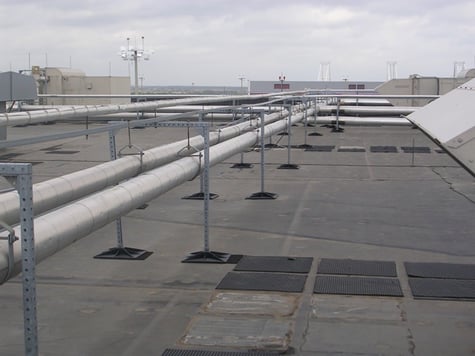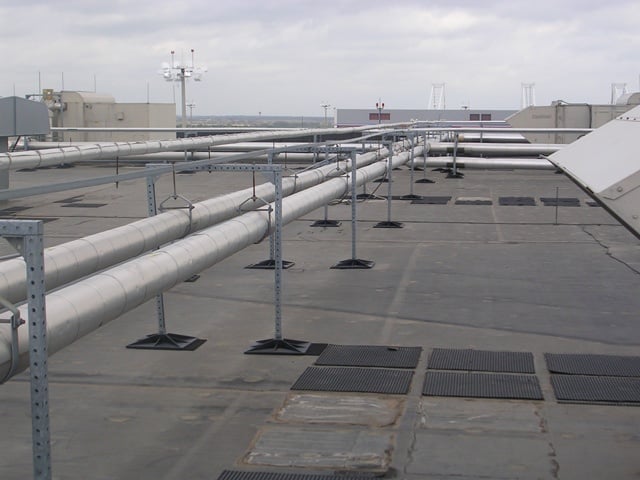
Not only is there more than one type of rooftop pipe support, there is also more than one way of attaching those pipe supports to the roof surface. But they all break down into one of two categories: penetrating vs. non-penetrating. Penetrating pipe supports attach mechanically through the roof membrane, while non-penetrating pipe supports sit on the surface of the roof and are anchored with ballast. And there are a number of benefits to that.
1. Extending the life of your roof
Every time you penetrate your roof’s membrane, you add another weak link to the roofing system. Sure, the contractor will seal the penetrations after installing the pipe supports, but those sealants aren’t foolproof. In addition, most sealants can, and do dry out and crack over time, giving moisture an opportunity to infiltrate your building, which can cause mold build-up, and—in the worst-case scenario—severe leaks that damage both the building itself as well as equipment and property inside the building. That can happen in a number of ways. If the penetration isn’t thoroughly cleaned before applying a sealant, for example, the sealant may not adhere. In the case of pitch pans, vibration can accelerate cracking of the sealant. And metal pans can rust, decreasing their ability to adhere to the sealant. It’s almost always better to avoid a penetration than to try to mitigate the effects.
2. Protecting your warranty
In many cases, penetrating the roof voids the warranty. In that case, the contractor and/or manufacturer would have an out even if the roof itself turned out to be defective or improperly installed. Check your warranty before allowing anything to penetrate your roof.
3. Reducing vibration
Vibration is a common occurrence with rooftop pipe supports. Supports that penetrate the roof transfer some of that vibration to the roof itself, which can result in both annoying noise levels and actual damage. Non-penetrating supports do a much better job of isolating that movement and evenly distributing the weight over the roof’s surface.
4. Simplifying re-roofing projects
When buildings with traditional, penetrating pipe supports need a new roof, both the pipes and their supports—as well as any other rooftop equipment—have to be moved, which can be expensive in terms of both labor and business disruption. Then they have to be reattached—penetrating your brand-new roof. Non-penetrating pipe supports can be shifted to the side, worked under and around, and then put right back in place.
5. Simplifying rerouting projects
It would be great if your rooftop layout served you for the life of the building. But the reality is that a business’s needs change. And what that business needs from its rooftop equipment changes right along with it. Whether it’s moving piping to the side to install a green roof that can serve as a company gathering spot, or tightening spacing to install additional equipment, it’s easier to reroute when your pipe supports don’t penetrate the roof. It’s also better for the roof itself, since the locations where the old supports penetrated don’t have to be repaired and sealed.
6. Reducing labor costs
It may seem insignificant in terms of the overall life of the roof, but using non-penetrating pipe supports can definitely affect upfront labor costs by eliminating the need to seal every penetration.
The bottom line is that zero-penetration pipe supports just make more sense. Every single penetration is a weak spot, and maintaining a sealed building envelope is challenging enough without asking for more trouble. Zero-penetration supports cost less to install, do a better job of protecting the life of your roof, and make any future changes a lot easier. What could be better than that?





